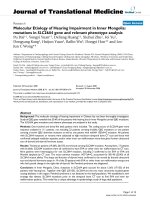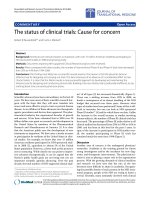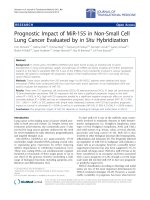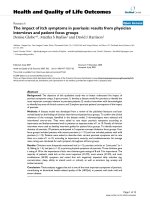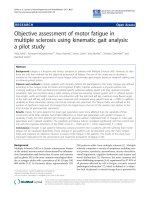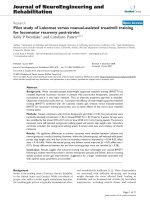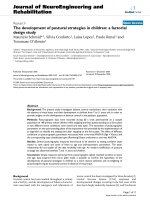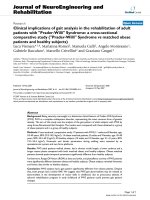báo cáo hóa học:" Mutational study of sapovirus expression in insect cells" potx
Bạn đang xem bản rút gọn của tài liệu. Xem và tải ngay bản đầy đủ của tài liệu tại đây (1.06 MB, 9 trang )
BioMed Central
Page 1 of 9
(page number not for citation purposes)
Virology Journal
Open Access
Research
Mutational study of sapovirus expression in insect cells
Grant S Hansman*, Kazuhiko Katayama, Tomoichiro Oka, Katsuro Natori
and Naokazu Takeda
Address: Department of Virology II, National Institute of Infectious Diseases, Tokyo, Japan
Email: Grant S Hansman* - ; Kazuhiko Katayama - ; Tomoichiro Oka - ;
Katsuro Natori - ; Naokazu Takeda -
* Corresponding author
Abstract
Human sapovirus (SaV), an agent of human gastroenteritis, cannot be grown in cell culture, but
expression of the recombinant capsid protein (rVP1) in a baculovirus expression system results in
the formation of virus-like particles (VLPs). In this study we compared the time-course expression
of two different SaV rVP1 constructs. One construct had the native sequence (Wt construct),
whereas the other had two nucleotide point mutations in which one mutation caused an amino acid
substitution and one was silent (MEG-1076 construct). While both constructs formed VLPs
morphologically similar to native SaV, Northern blot analysis indicated that the MEG-1076 rVP1
mRNA had increased steady-state levels. Furthermore, Western blot analysis and an antigen
enzyme-linked immunosorbent assay showed that the MEG-1076 construct had increased
expression levels of rVP1 and yields of VLPs. Interestingly, the position of the mutated residue was
strictly conserved residue among other human SaV strains, suggesting an important role for rVP1
expression.
Introduction
The family Caliciviridae is made up of four genera, Sapovi-
rus, Norovirus, Lagovirus, and Vesivirus, which contain
sapovirus (SaV), norovirus (NoV), rabbit hemorrhagic
disease virus, and feline calicivirus strains, respectively.
Human SaV and NoV strains are agents of gastroenteritis.
The prototype strain of human SaV, the Sapporo virus,
was originally discovered from an outbreak of gastroen-
teritis in an orphanage in Sapporo, Japan, in 1977 [1].
Chiba et al. identified viruses with the typical animal cal-
icivirus morphology, called the "Star of David" structure,
by electron microscopy (EM). SaV strains were recently
divided into five genogroups (GI to GV), of which GI, GII,
GIV, and GV strains infect humans, while GIII strains
infect porcine species [2]. The SaV GI, GIV, and GV
genomes are each predicted to contain three main open
reading frames (ORFs), whereas SaV GII and GIII have
two ORFs. SaV ORF1 encodes for non-structural proteins
and the major capsid protein (VP1). SaV ORF2 (VP2) and
ORF3 (VP3) encoded proteins of yet unknown functions.
The NoV genome is organized in a slightly different way
than the SaV, since ORF1 encodes all the nonstructural
proteins, ORF2 encodes the capsid protein (VP1), and
ORF3 encodes a small protein (VP2).
Human SaV and NoV strains are noncultivable, but
expression of the recombinant VP1 (rVP1) in a baculovi-
rus expression system results in the self-assembly of virus-
like particles (VLPs) that are morphologically similar to
native SaV [3,4] In a recent NoV expression study, a single
amino acid substitution in the rVP1 gene affected VLP for-
mation but not rVP1 expression [5]. In a different study,
Published: 23 February 2005
Virology Journal 2005, 2:13 doi:10.1186/1743-422X-2-13
Received: 28 January 2005
Accepted: 23 February 2005
This article is available from: />© 2005 Hansman et al; licensee BioMed Central Ltd.
This is an Open Access article distributed under the terms of the Creative Commons Attribution License ( />),
which permits unrestricted use, distribution, and reproduction in any medium, provided the original work is properly cited.
Virology Journal 2005, 2:13 />Page 2 of 9
(page number not for citation purposes)
inclusions of NoV ORF3 and poly(A) sequences in a con-
struct increased the expression levels of NoV rVP1 and the
stability of VLPs when compared to constructs without
these sequences [6]. Recently, cryo-EM analysis of SaV
VLPs and X-ray crystallography analysis of NoV VLPs pre-
dicted the SaV shell (S) and protruding domains (sub-
domains P1 and P2) that were based the NoV domains
[7,8]. Chen et al. also described strictly and moderately
conserved amino acid residues in the capsid protein
among the four genera in family Caliciviridae.
The purpose of this study was to compare the time-course
expression of two different SaV rVP1 constructs in a bacu-
lovirus expression system by Northern blotting, Western
blotting, enzyme-linked immunosorbent assay (ELISA),
and EM. Our novel results have indicated that nucleotide
point mutations increased the yields of SaV VLPs in insect
cells, offering an alternative explanation for the increased
expression levels of rVP1 and yield of VLPs.
Results
Wt, MQG-1076, and MEG-1076 constructs
Expression of SaV rVP1 in a baculovirus expression system
results in the self-assembly of VLPs [4]. However, during
PCR amplification nucleotide point mutations occurred
in our initial MQG-1076 construct, at nucleotide posi-
tions 4 and 1076 in VP1, which resulted in two amino
acid substitutions at residues 2 and 358, respectively, and
a silent nucleotide mutation at position 1895 in VP2 (Fig.
1). Despite these two substitutions the MQG-1076 con-
struct formed VLPs morphological similar to native SaV
(data not shown). In order to further investigate these
substitutions we expressed another construct (MEG-1076
construct) having only one substitution, at residue 358 in
VP1 (Fig. 1). This construct also formed VLPs. Finally we
expressed a construct (Wt construct) without these nucle-
otide point mutations, i.e., having the native sequence.
The Wt construct also formed VLPs, however the expres-
sion level of rVP1 was noticeably lower than those of the
MQG-1076 and MEG-1076 constructs in which had simi-
lar levels (data not shown). In order to compare expres-
sion levels, we infected Wt and MEG-1076 recombinant
baculoviruses each at a multiplicity of infection (MOI) of
14.5 in 2.7 × 10
6
confluent Tn5 cells in 1.5 ml of Ex-Cell
405 medium followed by incubation at 26°C. RNA tran-
scription and rVP1 expression experiments were run in
parallel for the Wt and MEG-1076 constructs.
Northern blot analysis
Total RNA was extracted from the cells at 1, 2, 3, 4, 5, 6, 7,
and 8 days postinfection (dpi) for Wt and MEG-1076 con-
structs. Equal amounts (500 ng) of total RNA were added
to a 2% agarose gel containing formaldehyde and stained
with SYBR Gold (Fig. 2A). The rVP1 mRNA was then ana-
lysed by Northern blot with a probe specific for the VP1
gene (native sequence) corresponding to the VP1 position
157 to 1283 (Fig. 1). The rVP1 mRNA transcript was pre-
dicted to be approximately 2300 nucleotides long. As
shown in Figure 2B, rVP1 mRNA was detected for each
construct. This result showed that the insert sequence and
some part of the baculovirus vector, approximately 300
nt, was transcribed, although the exact location(s) on the
vector has yet to be determined. Nevertheless, the MEG-
1076 construct had increased band intensities, indicating
an increased steady-state level, when compared to those of
the Wt construct (Fig. 2B). For the Wt construct, rVP1
mRNA was detected at 1 dpi, peaked at 2 dpi, decreased at
3 and 4 dpi, and then decreased to undetectable levels at
5, 6, 7, and 8 dpi. For the MEG-1076 construct, rVP1
mRNA was detected at 1 dpi, peaked at 2 dpi, had steady-
state levels at 3 and 4 dpi, and then decreased at 5 dpi but
could still be detected at 6, 7, and 8 dpi. These results indi-
cated that the MEG-1076 rVP1 mRNA also had greater sta-
bility when compared to those of the Wt rVP1 mRNA.
Schematics of the SaV constructs, Wt, MEG-1076, and MQG-1076, containing the rVP1, rVP2, and poly(A) sequencesFigure 1
Schematics of the SaV constructs, Wt, MEG-1076, and
MQG-1076, containing the rVP1, rVP2, and poly(A)
sequences. Each construct began at the predicted AUG start.
The triangles show the positions of the nucleotide point
mutations. The black triangle had an amino acid substitution
in the VP1, whereas the open triangle in the VP2 gene did not
change amino acid sequence. An RNA probe (anti-VP1) was
used to monitor the transcription of rVP1 mRNA in which
contained the native sequence, i.e., lacking the mutation at
1076.
MEG-1076
1895
1076
poly(A)
Wt
VP2
poly(A)
VP1
Anti-VP1
(probe)
157 1283
MQG-1076
1895
1076
poly(A)
4
Virology Journal 2005, 2:13 />Page 3 of 9
(page number not for citation purposes)
Western Blot analysis
Western blot analysis was used to compare the expression
levels of Wt and MEG-1076 rVP1. The culture medium
was separated from the cell lysate 1, 2, 3, 4, 5, 6, 7, and 8
dpi as described in the Materials and Methods. Equal vol-
umes of culture medium and cell lysate at each dpi were
used for both constructs. Proteins were separated by SDS-
PAGE, electrotransferred to PVDF, and detected with a
1:3000 dilution of hyperimmune rabbit Mc114 VLP
antiserum. A band at the predicted rVP1 size (60 K) was
first detected in the culture medium at 2 and 4 dpi for
MEG-1076 and Wt constructs, respectively, which
increased each day thereafter as evidenced by an increase
in band intensity (Fig. 3A). As indicated by increased band
intensities, the MEG-1076 construct expressed increased
levels of rVP1 (60 K) than those of the Wt construct. Sim-
ilarly, these results were reproduced using different MOIs
in order to address the variability in virus stock quality
(data not shown).
A thin band of approximately 55 K was also detected in
the culture medium that appeared at 4 and 5 dpi for Wt
and MEG-1076 constructs, respectively, and increased
each day thereafter. In a different experiment, we deter-
mined the amino acid sequence of the MQG-1076 upper
and lower bands by an Edman's degradation method. We
discovered that the first three amino acid residues were
MQG for both the upper and lower bands. This result
indicated that the 55 K bands for these constructs were
likely truncated or C-terminal deleted forms of rVP1. A
Northern Blot analysis of Wt and MEG-1076 rVP1 mRNAFigure 2
Northern Blot analysis of Wt and MEG-1076 rVP1 mRNA. The total RNA was purified from the cells at 1, 2, 3, 4, 5, 6, 7, and
8 dpi. (A) The relative amounts of total RNA for each construct. (B) The steady-state levels of rVP1 mRNA with an anti-VP1
probe specific for the VP1 gene, corresponding to the VP1 nucleotide position 157 to 1283.
Virology Journal 2005, 2:13 />Page 4 of 9
(page number not for citation purposes)
thin band of 60 K was detected at every dpi in the cell
lysate for the MEG-1076 construct (Fig. 3B), however the
intensity of this band did not increase to the same extent
as the MEG-1076 60 K band in the culture medium (Fig.
3A). This suggested that immediately after translation the
majority of rVP1 was rapidly exported from the cells to the
culture medium, though a fraction accumulated within
the cells. This may also explain why no 60 K bands were
detected in the cell lysate for Wt construct.
The VP2 amino acid sequence was the same in all con-
structs. We did not detect rVP2 during the time-course
expression of the MQG-1076 construct using the antise-
rum raised against E. coli expressed VP2 (data not shown).
Antigen ELISA and EM analysis of Wt and MEG-1076 VLPs
An antigen ELISA system was used to compare the yields
of Wt and MEG-1076 VLPs at 1, 2, 3, 4, 5, 6, 7, and 8 dpi.
The ELISA incorporated hyperimmune rabbit (capture)
and guinea pig (detector) antisera raised against purified
Mc114 VLPs [4]. The ELISA first detected VLPs at 2 and 3
dpi for MEG-1076 and Wt constructs, respectively (Fig. 4).
For both constructs, the yields of VLPs increased each day
thereafter, however the MEG-1076 construct had
increased yields of VLPs than those of the Wt construct at
4, 5, 6, 7, and 8 dpi, approximately 6-fold increase. EM
was used to verify the VLP formation of each of these con-
structs. We first detected VLPs at 4 dpi in the culture
medium for both constructs and the numbers of VLPs
increased each day thereafter (data not shown).
Amino acid analysis
The MEG-1076 construct contained a nucleotide point
mutation in which resulted in an amino acid substitution
at position 358 in VP1. We aligned 21 different VP1
amino acid sequences of SaV GI, GII, and GV strains and
found this residue was strictly conserved, but more impor-
tantly, there was a strictly conserved amino acid motif at
this site, NGDV (data not shown). However, when we
included a porcine SaV GIII strain and a recently identi-
fied SaV GIV strain (PEC and Hou-7, respectively), only
the GD site was strictly conserved, though several other
Western blot analysis of Wt and MEG-1076 rVP1Figure 3
Western blot analysis of Wt and MEG-1076 rVP1. Confluent Tn5 cells were infected with Mc114 recombinant baculoviruses at
MOI of 14.5 and incubated at 26°C. The culture medium, including the cells, were harvested 1, 2, 3, 4, 5, 6, 7, and 8 dpi as
described in the materials and methods. (A) The cell culture medium was concentrated by ultracentrifugation, resuspended in
20 µl of Grace's medium, and 5 µl was mixed with loading dye and loaded into each well. (B) The cell lysate was separated from
the culture medium, resuspended in 200 µl of Grace's medium, and 5 µl was mixed with loading dye and loaded into each well.
Virology Journal 2005, 2:13 />Page 5 of 9
(page number not for citation purposes)
amino acids nearby were also strictly conserved (Fig. 5).
Further analysis of other SaV GIV strains are clearly
needed in order to examine the possibility that the NGDV
motif was moderately conserved in other human SaV
strains. Figure 5 also showed that the predicted SaV P2
domain had very few conserved amino acid residues.
Apart from the strictly conserved GD motif, the only other
strictly conserved motif in the P2 domain was at the 5'
end.
Discussion
Expression of the human SaV rVP1 in a baculovirus
expression system was first reported in 1997 [9]. In that
study, the full-length VP1 gene, ORF2, and poly(A)
sequences were included in a construct (Sapporo strain,
GI). The second human SaV reported to form VLPs was
with a construct (Houston/90 strain, GI) using only the
VP1 sequence, i.e., lacking ORF2 and poly(A) sequences
[10], while the third human SaV reported to form VLPs
used a construct (Parkville strain, GI) with only VP1 and
ORF2 sequences, i.e., lacking poly(A) sequence [7]. We
recently expressed human SaV GI, GII, and GV rVP1 with
constructs (Mc14, C12, and NK24 strains, respectively)
that included ORF2 and poly(A) sequences [4]. Addi-
tional information on human SaV rVP1 expression is lack-
ing, although it appeared that the yields of human SaV
VLPs were typically low for these three genogroups.
In this study, we compared the time-course expression of
two different Mc114 SaV rVP1 constructs in a baculovirus
expression system (Fig. 1). The MEG-1076 construct had
two nucleotide point mutations, one in the VP1 gene in
which resulted in an amino acid substitution, and one in
the VP2 gene in which was silent. Although both con-
structs formed VLPs morphological similar to native SaV,
the levels of transcription, translation, and VLP formation
were clearly different. As shown in Figure 2B, the MEG-
1076 rVP1 mRNA had increased steady-state levels and
greater stability when compared to those of the Wt rVP1
mRNA. This difference was understood to be due to the
nucleotide mutations in the MEG-1076 construct, since a
similar result was observed in a NoV expression study [6].
Bertolotti-Ciarlet et al. found that a nucleotide point
mutation in a NoV rVP1 construct (ORF2-AUG
→
ACG-
ORF3+3' UTR construct, represented in bold) had
decreased levels of rVP1 mRNA at 36 hours post-infection,
Antigen ELISA analysis of Wt and MEG-1076 VLPsFigure 4
Antigen ELISA analysis of Wt and MEG-1076 VLPs. The ELISA used hyperimmune rabbit (capture) and guinea pig (detector)
antiserum raised against Mc114 VLPs. For the antigen ELISA, purified Mc114 VLPs were used as the positive control at concen-
trations ranging from 500 ng to 0.24 ng.
Virology Journal 2005, 2:13 />Page 6 of 9
(page number not for citation purposes)
by approximately 50%, when compared to a construct
without the mutation (ORF2+ORF3+3' UTR construct).
Bertolotti-Ciarlet suggested that the RNA secondary struc-
ture or changes in the mRNA stability could be responsi-
ble for the different steady-state levels, but this was not
proven.
Also, the MEG-1076 construct had increased levels of
rVP1 expression and yields of VLPs in the culture medium
when compared to those of the Wt construct (Fig. 3A). On
the other hand, the concentration of rVP1 in the cell lysate
remained more or less the same during the time-course
expression for the MEG-1076 construct. And for the Wt
construct, rVP1 was not detected in the cell lysate,
although this may have been related to the low expression
levels (Fig. 3B). Our results showed that the MEG-1076
construct had a 6-fold increase in yields of VLPs in the cul-
ture medium (Fig. 4), which corresponded to approxi-
mately 80 µg of CsCl purified VLPs from 200 ml of culture
medium (at 6 dpi), but less than 5 µg of CsCl purified
VLPs in the cell lysate (data not shown). These results sug-
gested that either (i) immediately after translation the
majority of rVP1 was exported from the cells to the culture
medium where the majority of VLPs were folded but a
fraction were simultaneously folded within the cells or (ii)
VLPs were folded within the cells and then the majority of
VLPs were immediately exported from the cells to the cul-
ture medium, though a fraction remained within the cells.
In a recent NoV expression study, a single amino acid sub-
stitution in the rVP1 gene affected VLP formation but not
rVP1 expression [5]. In that study, a (native) histidine res-
idue at position 91 (relative to NoV Snow Mountain Virus
strain amino acid VP1 sequence) was found to be essential
for VLP formation and a construct with a substituted
(mutant) arginine residue at this position failed to form
VP1 amino acid alignment of SaV GI, GII, GIII, GV, and GV strainsFigure 5
VP1 amino acid alignment of SaV GI, GII, GIII, GV, and GV strains. We originally aligned 21 SaV GI, GII, and GV sequences but
to simplify the figure we used one representative strain from each genogroup. The green bar shows the SaV P2 domain pre-
dicted by Chen et al. [7]. The asterisks indicate conserved amino acids. We originally aligned 21 different VP1 amino acid
sequences of SaV GI, GII, and GV strains and found the residue (N) at position 358 (yellow) was strictly conserved (data not
shown), but SaV GIII and GIV strains (PEC and Hou-7, respectively) had other residues at this position. The alignment of the
five SaV genogroups showed the amino acid motif, GD, was strictly conserved (red) and several other amino acids surrounding
the residue at position 358 were also strictly conserved (red).
Virology Journal 2005, 2:13 />Page 7 of 9
(page number not for citation purposes)
VLPs despite expressing rVP1. Interestingly, that study
found a single amino substitution was critical for the for-
mation of VLPs, whereas our results showed that a single
amino acid substitution was beneficial, i.e., increased the
yields of VLPs. Bertolotti-Ciarlet found that inclusions of
NoV ORF3 and poly(A) sequences in a construct increased
the expression levels of NoV rVP1 and the stability of VLPs
when compared to constructs without these sequences;
and suggested that expression of other caliciviruses (NoV
and SaV) rVP1 that resulted in low yields or unstable VLPs
may be due to constructs that lacked the VP2 gene [6]. An
alternative explanation was that point mutations
influenced steady-state levels of mRNA and stability,
which in turn influenced VLP formation. In our case, one
or two nucleotide point mutations caused an enhance-
ment of transcription, leading to increased yields of SaV
VLPs in insect cells. Furthermore, many of these studies
that expressed calicivirus rVP1 in insect cells only exam-
ined rVP1 expression and yields of VLPs but not rVP1
mRNA transcription [11-14]. However, another reason for
the increased yields of VLPs may be associated with adap-
tation of SaV rVP1 to the baculovirus expression system
and insect cells, since a similar result was observed with
porcine enteric calicivirus in primary kidney cells [15].
Although the growth rate and replication efficiency of the
recombinant baculoviruses themselves and differences in
the levels of virus replication might account for such vari-
ation, we observed similar results using other MOIs, that
is, the MEG-1076 construct continued to express greater
yields of VLPs than the Wt construct (data not shown).
Another explanation may have been differences in the
extents to which these baculoviruses induce apoptosis and
all these may result from features in the baculovirus skel-
eton rather than from the inserted SaV sequence. Such
effects might for instance affect the number of adherent
cells harvested or the degradation rates of both proteins
and RNAs. However, we found that the MQG-1076 con-
struct, developed from a separate experiment, had similar
expression levels to that of the MEG-1076 construct (data
not shown), which may eliminate the possibility that the
baculovirus skeleton played a role in the increased yields
of VLPs. On the other hand, we could not demonstrate
whether the nucleotide mutations in VP1 and/or in ORF2
affected the transcription, a construct with only one of
these mutations would be needed. Nevertheless, our
results indicate that translation was exclusively affected by
the single amino acid substitution in VP1. Therefore, the
final increase in yields of VLPs may have been coupled at
multiple levels, involving one or both of the nucleotide
mutations in VP1 and VP2.
We did not detect rVP2 during the time-course expression
of the MQG-1076 construct (data not shown). The Wt and
MEG-1076 constructs had an identical amino acid
sequence, which would suggest a similar negative-result.
NoV studies have found that inclusion of VP2 increases
the stability of VLPs, though the expression level of NoV
rVP2 was low [6]. These results may suggest that (i) SaV
rVP2 was expressed at undetectable levels, (ii) SaV rVP2
was not expressed in the insect cells, or (iii) SaV rVP2 was
degraded in the insect cells. The SaV GI, GIV, and GV
genomes are each predicted to encode a third ORF (ORF3)
overlapping the VP1 gene, whereas SaV GII and GIII have
only two ORFs. The functions of SaV ORF2 and ORF3 still
remain unknown.
The amino acid substitution (N → S) for the MEG-1076
construct occurred in the VP1 gene at residue 358. This
asparagine residue was recently identified as a moderately
conserved residue among the caliciviruses capsid proteins
[7], but more importantly, the residue was strictly con-
served among 21 different SaV GI, GII, and GV strains and
belonged to a strictly conserved amino acid motif, NGDV
(Fig. 5). However, when we included SaV GIII and GIV
strains (PEC and Hou-7, respectively) we found that only
the GD amino acids were strictly conserved though several
other amino acids nearby were also strictly conserved (Fig.
5). These data further suggested that this site played an
important role in the regulation of SaV VLP formation.
Recently, the cryo-EM analysis of SaV was determined and
compared to NoV X-ray crystallography structure [7].
Chen et al. analysed 30 different VP1 amino acid
sequences of calicivirus strains belonging to the four gen-
era in the family Caliciviridae and identified strictly and
moderately conserved residues, and predicted the P1 and
P2 domains of SaV VP1 based on NoV X-ray crystallogra-
phy structure. Based on these predictions, the residue at
position 358 (amino acid sequence) was found as a mod-
erately conserved residue among the caliciviruses. This
arginine residue was predicated to be in the P2 domain,
which is defined as the outer most protruding domain for
NoV and thought to provide strain diversity [16]. Further
high-resolution structural analysis of SaV VLPs is clearly
needed in order to determine the precise domains and
regions of SaV. However, our expression results have indi-
cated that only approximately 80 µg of purified VLPs from
200 ml of culture medium was possible (data not shown),
thus in order to determine the X-ray crystallography struc-
ture of SaV, a minimum increase in expression level of
about 20-fold would be required: a challenging feat.
Materials and methods
Virus strain, RNA extraction, cDNA synthesis
SaV GI Mc114 strain (GenBank accession number,
AY237422) was isolated from a male infant seven months
of age from the McCormic Hospital, Chiang Mai, Thai-
land on the 7th May 2001 [17]. RNA extraction and cDNA
synthesis were performed as previously described [18].
Virology Journal 2005, 2:13 />Page 8 of 9
(page number not for citation purposes)
PCR and sequencing
Our initial SaV rVP1 construct (MQG-1076 construct) was
amplified with ExTaq DNA polymerase. However, this
construct was later found to have two nucleotide point
mutations in ORF1 at positions 4 (GAG → CAG) and
1076 (AAT → AGT) and one nucleotide point mutation in
ORF2 at position 1895 (GTG → GTA) (relative to the VP1
start and represented in bold). Primer and PCR errors
likely introduced these mutations. These three nucleotide
point mutations resulted in two amino acid substitutions
in the VP1 gene, one at the second residue, where
glutamic acid (E) → glutamine (Q), and one at residue
358, where asparagine (N) → serine (S). The nucleotide
point mutation in ORF2 did not result in an amino sub-
stitution. Despite the two amino acid substitutions, the
MQG-1076 construct formed VLPs. We designed another
construct (MEG-1076) using the pDEST8-MQG-1076 as
template but with a new sense primer and used KOD-plus
DNA polymerase according to the manufacture's instruc-
tions (Toyobo, Japan). The MEG-1076 construct had the
same nucleotide point mutations at positions 1076 in
VP1 and 1895 in VP2 as the MQG-1076 construct but not
at nucleotide 4 in VP1 (Fig. 1). Lastly, we designed a third
construct with the native sequence (Wt construct) using
KOD-plus DNA polymerase and the original cDNA [4].
PCR-amplified fragments were cloned into the Gateway
Expression System (Invitrogen, Carlsbad, Calif.) as previ-
ously described [4]. The insert sequences of the pDONR8
plasmids were confirmed, including the partial upstream
and downstream sequences on the plasmids in which
were found to be identical for the Wt and MEG-1076
constructs. Sequencing was performed as previously
described [18].
Expression of rVP1 in insect cells
Recombinant bacmids were transfected into Sf9 cells
(Riken Cell Bank, Japan) and the recombinant baculovi-
ruses was collected as previously described [4]. The
expression of the rVP1 constructs were analyzed by infect-
ing recombinant baculoviruses at a MOI of 14.5 in 2.7 ×
10
6
confluent Tn5 cells in 1.5 ml of Ex-Cell 405 medium
followed by incubation at 26°C. The total culture
medium was harvested 1, 2, 3, 4, 5, 6, 7, and 8 dpi. The
culture medium was centrifuged for 10 min at 3,000 × g,
and further centrifuged for 30 min at 10,000 × g. The VLPs
in the culture medium were further concentrated by ultra-
centrifugation for 2 h at 45,000 rpm at 4°C (Beckman
TLA-55 rotor), and then resuspended in 30 µl of Grace's
medium. The cell lysate from the first centrifuge was resus-
pended in 200 µl of Grace's medium and stored at 4°C.
Northern blotting
Total RNA was prepared from the attached cells at 1, 2, 3,
4, 5, and 6 dpi with 1 ml of Isogen (Nippon Gene, Japan).
For 7 and 8 dpi, the cell culture medium (containing unat-
tached cells) was collected and centrifuged for 5 min at
3,000 × g, the supernatant removed, and then the cells
were dissolved with 1 ml of Isogen. The cells were stored
at -80°C. RNA was purified by a chloroform/ ethanol
method (Nippon Gene, Japan). Briefly, RNA was mixed
with chloroform, centrifuged at 12,000 × g for 15 min at
4°C, and the aqueous layer collected. This was repeated
once, and then the aqueous layer collected and mixed
with isopropanol and stored overnight at -20°C. The solu-
tion was mixed, centrifuged at 12,000 × g for 15 min at
4°C, and the supernatant discarded. The pellet was resus-
pended in 80% ethanol, centrifuged at 12,000 × g for 15
min at 4°C. This was repeated once, and then the pellet
air-dried and resuspended in 25 µl of TE, and stored at -
80°C. The amounts of purified RNA were determined
spectrophotometrically (Bio-Rad, USA). The same
amounts (500 ng) of total RNA were loaded for each con-
struct and each dpi onto a 2% denaturing agarose gel con-
taining formaldehyde. The amounts of total RNA were
compared using SYBR Gold staining (Invitrogen, USA).
RNA was transferred to a positively charged nylon transfer
membrane (Hybond-N+; Amersham Biosciences, Ireland)
under vacuum (VacuGene XL; Pharamacia LKB, Sweden)
and analyzed by Northern blotting according to the DIG
Northern Starter Kit (Roche, USA), except for a minor
modification. Briefly, a RNA probe corresponding to
Mc114 VP1 position 157 to 1283 (anti-VP1) was gener-
ated from a PCR fragment (native sequence) according to
the manufacture's instructions (Roche, USA). Hybridiza-
tion was performed overnight at 68°C with anti-VP1 in 10
ml of ultrasensitive hybridization buffer (Ambion, Can-
ada). After hybridization, immunological detection was
performed according to the manufacture's instructions
(Roche, USA).
Western blotting, ELISA, EM, and protein sequencing
Western blotting, ELISA, and EM were used to examine
rVP1 expression as previously described [4]. However, it
should be acknowledged that the hyperimmune rabbit
and guinea pig antisera were raised against the MQG-
1076 VLPs. Protein sequences were determined by an
Edman's degradation method.
Amino acid alignment
VP1 nucleotide sequences were translated using Genetyx
software (software development Co. Version 11.2.2) and
submitted to online ClustalW at DDBJ http://spi
ral.genes.nig.ac.jp/homology/welcome-e.shtml. In total,
we aligned different 21 SaV GI, GII, GIII, GIV, and GV
sequences, and included: Arg39, AY289803; Bristol,
AJ249939; C12, AY603425; Cruise ship/00, AY289804;
PEC, AF182760; Dresden, AY694184; Hou-7, AF435814;
Houston/86/US, U95643; Houston/27/90/US, U95644;
London/29845/92/UK, U95645; Lyon/598/97/F,
AJ271056; Manchester, X86560; Mc2, AY237419; Mc10,
Publish with BioMed Central and every
scientist can read your work free of charge
"BioMed Central will be the most significant development for
disseminating the results of biomedical research in our lifetime."
Sir Paul Nurse, Cancer Research UK
Your research papers will be:
available free of charge to the entire biomedical community
peer reviewed and published immediately upon acceptance
cited in PubMed and archived on PubMed Central
yours — you keep the copyright
Submit your manuscript here:
/>BioMedcentral
Virology Journal 2005, 2:13 />Page 9 of 9
(page number not for citation purposes)
AY237420; Mex340/1990, AF435812; Mex14917/00,
AF435813; NK24, AY646856; Parkville, U73124; Pots-
dam, AAG01042; Plymouth, X86559; Sapporo/82/Japan,
U65427; and Sakaeo-15, AY646855.
Competing interests
The author(s) declare that they have no competing
interests.
Authors' contributions
GH carried out the study and wrote the manuscript. KK,
TO, KN, and NT participated in the design of the study
and helped to draft the manuscript.
Acknowledgements
This work was supported by Grants-in-aid from The Ministry of Education,
Culture, Sports, Science and Technology, Japan and a Grant for Research
on Re-emerging Infectious Diseases from The Ministry of Health, Labour,
and Welfare, Japan. We are grateful to the Japanese Monbusho for the PhD
scholarship provided to Grant Hansman.
References
1. Chiba S, Sakuma Y, Kogasaka R, Akihara M, Horino K, Nakao T, Fukui
S: An outbreak of gastroenteritis associated with calicivirus
in an infant home. J Med Virol 1979, 4(4):249-254.
2. Farkas T, Zhong WM, Jing Y, Huang PW, Espinosa SM, Martinez N,
Morrow AL, Ruiz-Palacios GM, Pickering LK, Jiang X: Genetic diver-
sity among sapoviruses. Arch Virol 2004, 149(7):1309-1323.
3. Jiang X, Wang M, Graham DY, Estes MK: Expression, self-assem-
bly, and antigenicity of the Norwalk virus capsid protein. J
Virol 1992, 66(11):6527-6532.
4. Hansman GS, Natori K, Oka T, Ogawa S, Tanaka K, Nagata N, Ushi-
jima H, Takeda N, Katayama K: Cross-reactivity among sapovi-
rus recombinant capsid proteins. Arch Virol 2005, 150(1):21-36.
5. Lochridge VP, Hardy ME: Snow Mountain virus genome
sequence and virus-like particle assembly. Virus Genes 2003,
26(1):71-82.
6. Bertolotti-Ciarlet A, Crawford SE, Hutson AM, Estes MK: The 3'
end of Norwalk virus mRNA contains determinants that reg-
ulate the expression and stability of the viral capsid protein
VP1: a novel function for the VP2 protein. J Virol 2003,
77(21):11603-11615.
7. Chen R, Neill JD, Noel JS, Hutson AM, Glass RI, Estes MK, Prasad BV:
Inter- and intragenus structural variations in caliciviruses
and their functional implications. J Virol 2004, 78(12):6469-6479.
8. Prasad BV, Hardy ME, Dokland T, Bella J, Rossmann MG, Estes MK:
X-ray crystallographic structure of the Norwalk virus capsid.
Science 1999, 286(5438):287-290.
9. Numata K, Hardy ME, Nakata S, Chiba S, Estes MK: Molecular char-
acterization of morphologically typical human calicivirus
Sapporo. Arch Virol 1997, 142(8):1537-1552.
10. Jiang X, Zhong W, Kaplan M, Pickering LK, Matson DO: Expression
and characterization of Sapporo-like human calicivirus cap-
sid proteins in baculovirus. J Virol Methods 1999, 78(1-2):81-91.
11. Guo M, Qian Y, Chang KO, Saif LJ: Expression and self-assembly
in baculovirus of porcine enteric calicivirus capsids into
virus-like particles and their use in an enzyme-linked immu-
nosorbent assay for antibody detection in swine. J Clin Microbiol
2001, 39(4):1487-1493.
12. Belliot G, Noel JS, Li JF, Seto Y, Humphrey CD, Ando T, Glass RI,
Monroe SS: Characterization of capsid genes, expressed in the
baculovirus system, of three new genetically distinct strains
of "Norwalk-like viruses". J Clin Microbiol 2001,
39(12):4288-4295.
13. Barcena J, Verdaguer N, Roca R, Morales M, Angulo I, Risco C, Car-
rascosa JL, Torres JM, Caston JR: The coat protein of Rabbit
hemorrhagic disease virus contains a molecular switch at the
N-terminal region facing the inner surface of the capsid. Virol-
ogy 2004, 322(1):118-134.
14. Jiang X, Zhong WM, Farkas T, Huang PW, Wilton N, Barrett E, Fulton
D, Morrow R, Matson DO: Baculovirus expression and anti-
genic characterization of the capsid proteins of three Nor-
walk-like viruses. Arch Virol 2002, 147(1):119-130.
15. Guo M, Chang KO, Hardy ME, Zhang Q, Parwani AV, Saif LJ: Molec-
ular characterization of a porcine enteric calicivirus geneti-
cally related to Sapporo-like human caliciviruses. J Virol 1999,
73(11):9625-9631.
16. Nilsson M, Hedlund KO, Thorhagen M, Larson G, Johansen K,
Ekspong A, Svensson L: Evolution of human calicivirus RNA in
vivo: accumulation of mutations in the protruding P2
domain of the capsid leads to structural changes and possibly
a new phenotype. J Virol 2003, 77(24):13117-13124.
17. Hansman GS, Katayama K, Maneekarn N, Peerakome S, Khamrin P,
Tonusin S, Okitsu S, Nishio O, Takeda N, Ushijima H: Genetic
diversity of norovirus and sapovirus in hospitalized infants
with sporadic cases of acute gastroenteritis in Chiang Mai,
Thailand. J Clin Microbiol 2004, 42(3):1305-1307.
18. Katayama K, Shirato-Horikoshi H, Kojima S, Kageyama T, Oka T,
Hoshino F, Fukushi S, Shinohara M, Uchida K, Suzuki Y, Gojobori T,
Takeda N: Phylogenetic analysis of the complete genome of
18 Norwalk-like viruses. Virology 2002, 299(2):225-239.
